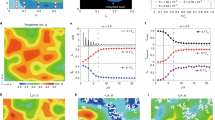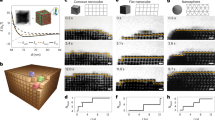Abstract
Understanding crystal growth is essential for controlling the crystallization used in industrial separation and purification processes. Because solids interact through their surfaces, crystal shape can influence both chemical and physical properties1. The thermodynamic morphology can readily be predicted2, but most particle shapes are actually controlled by the kinetics of the atomic growth processes through which assembly occurs3. Here we study the urea–solvent interface at the nanometre scale and report kinetic Monte Carlo simulations of the micrometre-scale three-dimensional growth of urea crystals. These simulations accurately reproduce experimentally observed crystal growth. Unlike previous models of crystal growth4,5,6, no assumption is made that the morphology can be constructed from the results for independently growing surfaces or from an a priori specification of surface defect concentration. This approach offers insights into the role of the solvent, the degree of supersaturation, and the contribution that extended defects (such as screw dislocations) make to crystal growth. It also connects observations made at the nanometre scale, through in situ atomic force microscopy, with those made at the macroscopic level. If extended to include additives, the technique could lead to the computer-aided design of crystals.
This is a preview of subscription content, access via your institution
Access options
Subscribe to this journal
Receive 51 print issues and online access
$199.00 per year
only $3.90 per issue
Buy this article
- Purchase on Springer Link
- Instant access to full article PDF
Prices may be subject to local taxes which are calculated during checkout




Similar content being viewed by others
References
Winn, D. & Doherty, M. F. Modeling crystal shapes of organic materials grown from solution. Am. Inst. Chem. Eng. J. 46, 1348–1367 (2000)
Gibbs, J. W. Collected Works (eds Longley, W. R. & van Name, R. G.) (Longman, New York, 1928)
Rodriguez-Hornedo, N. & Murphy, D. Significance of controlling crystallization mechanisms and kinetics in pharmaceutical systems. J. Pharm. Sci. 88, 651–660 (1999)
Hartman, P. & Perdok, W. G. On the relations between structure and morphology of crystals. Acta Crystallogr. 8, 48–52 (1955)
Pina, C. M., Becker, U., Risthous, P., Bosbach, D. & Putnis, A. Molecular-scale mechanisms of crystal growth of barite. Nature 395, 483–486 (1998)
Liu, X. Y., Boek, E. S., Briels, W. J. & Bennema, P. Prediction of crystal growth morphology based on structural analysis of the solid-fluid interface. Nature 374, 342–345 (1995)
Davey, R. J., Mullin, J. W. & Whiting, M. J. L. Habit modification of succinic acid crystals grown from different solvents. J. Cryst. Growth 58, 304–312 (1982)
Piana, S. & Gale, J. D. Understanding the barriers to crystal growth: Dynamical simulation of the dissolution and growth of urea from aqueous solution. J. Am. Chem. Soc. 127, 1975–1982 (2005)
Wulff, G. Zur frage der geschwindigkeitb des wachsthums und der auflosung der krystallflachen. Z. Krist. 34, 449–530 (1901)
Gillespie, D. T. A general method for numerically simulating the stochastic time evolution of coupled chemical reactions. J. Comp. Phys. 22, 403–434 (1976)
Jónsson, H. Theoretical studies of atomic scale processes relevant to crystal growth. Annu. Rev. Phys. Chem. 51, 623–653 (2000)
Boerrigter, S. X. M. et al. MONTY: Monte Carlo crystal growth on any crystal structure in any crystallographic orientation; application to fats. J. Phys. Chem. A 108, 5894–5902 (2004)
Davey, R., Fila, W. & Garside, J. The influence of biuret on the growth kinetics of urea crystals from aqueous solutions. J. Cryst. Growth 79, 607–613 (1986)
Land, T. A., Martin, T. L., Potapenko, S., Palmore, G. T. & de Yoreo, J. J. Recovery of surfaces from impurity poisoning during crystal growth. Nature 399, 442–445 (1999)
Fleming, S. D. & Rohl, A. L. GDIS: a visualization program for molecular and periodic systems. Z Krist. 220, 1–5 (2005)
Swaminathan, S., Craven, B. M., Spackman, M. A. & Stewart, R. F. Theoretical and experimental studies of the charge density in urea. Acta Crystallogr. B 40, 398–404 (1984)
Lindhal, E., Hess, B. & van der Spoel, D. GROMACS 3.0: a package for molecular simulation and trajectory analysis. J. Mol. Modeling 7, 306–317 (2001)
Smith, L. J., Berendsen, H. J. C. & van Gusteren, W. F. Computer simulation of urea-water mixtures: A test of force field parameters for use in biomolecular simulation. J. Phys. Chem. B 108, 1065–1071 (2004)
van Gusteren, W. F., et al. Biomolecular Simulation: the GROMOS96 Manual and User Guide 1–1024 (Vdf Hochschulverlag AG an der ETH Zurich, Zurich, 1996)
Essman, U. et al. A smooth particle mesh Ewald method. J. Chem. Phys. 103, 8577–8593 (1995)
Pinck, L. A. & Kelly, M. A. The solubility of urea in water. J. Am. Chem. Soc. 47, 2170–2172 (1925)
Boomadevi, S., Dhanasekaran, R. & Ramasamy, P. Investigations on nucleation and growth kinetics of urea crystals from methanol. Cryst. Res. Technol. 37, 159–168 (2002)
Acknowledgements
We are grateful to A. Rohl for discussions, and to T. Dincer for assistance with the optical microscope. S.P. acknowledges financial support from an Australian Research Fellowship, while S.P. and J.D.G. both gratefully acknowledge the support of the Government of Western Australia through the Premiers Research Fellowship programme. Author Contributions S.P. performed all the calculations and the optical microscopy, M.R. produced the atomic force microscope images, J.D.G. conceived the project and wrote the manuscript with S.P.
Author information
Authors and Affiliations
Corresponding author
Ethics declarations
Competing interests
Reprints and permissions information is available at npg.nature.com/reprintsandpermissions. The authors declare no competing financial interests.
Supplementary information
Supplementary Notes
This contains Supplementary Methods, Supplementary Tables (including tabulations of the rate constants derived from the molecular dynamics and used in the kinetic Monte Carlo simulations) and additional references. (DOC 300 kb)
Rights and permissions
About this article
Cite this article
Piana, S., Reyhani, M. & Gale, J. Simulating micrometre-scale crystal growth from solution. Nature 438, 70–73 (2005). https://doi.org/10.1038/nature04173
Received:
Accepted:
Issue Date:
DOI: https://doi.org/10.1038/nature04173
This article is cited by
-
Influences of Crystal Anisotropy in Pharmaceutical Process Development
Pharmaceutical Research (2018)
-
Copper(I) oxide micro-cubical structures formation by metal organic chemical vapor deposition from copper(II) acetylacetonate
Journal of Materials Science (2013)
-
Nanoporous ZnO nanostructures for photocatalytic degradation of organic pollutants
Applied Physics A (2013)
-
Polymer-Mediated Anti-solvent Crystallization of Nitrendipine: Monodispersed Spherical Crystals and Growth Mechanism
Pharmaceutical Research (2012)
Comments
By submitting a comment you agree to abide by our Terms and Community Guidelines. If you find something abusive or that does not comply with our terms or guidelines please flag it as inappropriate.



